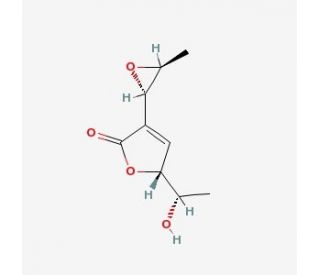

Asperlactone (CAS 76375-62-7)
ACCÈS RAPIDE AUX LIENS
L'asperlactone est un composé qui agit comme un puissant inhibiteur de certaines enzymes impliquées dans des processus cellulaires. Il exerce son mécanisme d'action en se liant au site actif de l'enzyme cible, perturbant ainsi son fonctionnement normal. Cette interférence conduit finalement à l'inhibition de voies biochimiques spécifiques au sein de la cellule. Le mécanisme d'action de l'asperlactone implique la perturbation d'interactions moléculaires clés, ce qui entraîne la modulation de la signalisation cellulaire et des voies métaboliques. L'asperlactone joue un rôle dans la régulation des processus cellulaires en ciblant et en inhibant l'activité de l'enzyme, influençant ainsi l'activité biochimique au sein de la cellule. Son mécanisme d'action implique une liaison spécifique à l'enzyme cible, entraînant la perturbation de sa fonction catalytique et un impact ultérieur sur les processus cellulaires.
Asperlactone (CAS 76375-62-7) Références
- Characterization and regulation of new secondary metabolites from Aspergillus ochraceus M18 obtained by UV mutagenesis. | Awad, G., et al. 2005. Can J Microbiol. 51: 59-67. PMID: 15782235
- Chlorohydroaspyrones A and B, antibacterial aspyrone derivatives from the marine-derived fungus Exophiala sp. | Zhang, D., et al. 2008. J Nat Prod. 71: 1458-60. PMID: 18661951
- Cloning and characterization of novel methylsalicylic acid synthase gene involved in the biosynthesis of isoasperlactone and asperlactone in Aspergillus westerdijkiae. | Bacha, N., et al. 2009. Fungal Genet Biol. 46: 742-9. PMID: 19589392
- Nine new and five known polyketides derived from a deep sea-sourced Aspergillus sp. 16-02-1. | Chen, XW., et al. 2014. Mar Drugs. 12: 3116-37. PMID: 24871461
- Chemical Composition of Aspergillus creber Extract and Evaluation of its Antimicrobial and Antioxidant Activities. | Sakhri, A., et al. 2019. Pol J Microbiol. 68: 309-316. PMID: 31880876
- Secondary Metabolites and Bioactivities of Aspergillus ochraceopetaliformis Isolated from Anthurium brownii. | Hu, HC., et al. 2020. ACS Omega. 5: 20991-20999. PMID: 32875235
- A new lactone from mangrove endophytic fungus Aspergillus sp. GXNU-A9. | Zhang, W., et al. 2023. Nat Prod Res. 37: 417-423. PMID: 34937443
- Genome and Metabolome MS-Based Mining of a Marine Strain of Aspergillus affinis. | Gonçalves, MFM., et al. 2021. J Fungi (Basel). 7: PMID: 34947073
- Whole genome sequencing of Penicillium and Burkholderia strains antagonistic to the causal agent of kauri dieback disease (Phytophthora agathidicida) reveals biosynthetic gene clusters related to antimicrobial secondary metabolites. | Byers, AK., et al. 2023. Mol Ecol Resour.. PMID: 37208988
Informations pour la commande
| Nom du produit | Ref. Catalogue | COND. | Prix HT | QTÉ | Favoris | |
Asperlactone, 1 mg | sc-202962 | 1 mg | $205.00 | |||
Asperlactone, 5 mg | sc-202962A | 5 mg | $367.00 |
